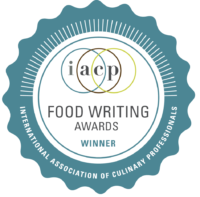The first time Himself and I ventured into a Korean restaurant, we accumulated 18 little plates on our table BEFORE our order arrived–and all we’d asked for was an appetizer and two entrées! So if you like to sample loads of different dishes, a Korean meal will surely please you on that score. And if you like your meal heavy on the garlic and pickles, you’ll be positively thrilled.
For this latest trip I made a lunch date with Charles Rosenberg, who lives right smack in the middle of Koreatown. This is his home turf, but I managed to find a good spot he’d never heard of. Booyah! Mountain Cafe is open 24 hours a day and is one of those places the locals know and cherish. While most people are familiar with Korean barbecue, this place is all about the soup. Apparently it’s THE go-to place for a restorative bowl of porridge at 3 a.m., when the parties are winding down and everyone has indulged a bit too much. I just can’t do 3 a.m. the way I used to, so we went for lunch, a sane hour and a manageable crowd.
We started with an order of b(r)oiled ravioli. I’m typing it this way because the menu said “broiled,” but our dumplings were quite obviously “boiled.” No matter. Each one was like a tiny meal unto itself, with a little bit of ground beef, mixed vegetables and noodles tucked inside. Dipped in the kimchi juices, they made a good starter.
These myriad sides, called banchan, remind me of all the sides called “salads” you get in an Israeli restaurant. Most banchan are some form of kimchi, a pickled vegetable of some sort (ours includes cabbage and Asian radish), although the bowl in the upper left hand corner contains chunks of sweet beef. This is actually a quite modest spread, as banchan go.
Pickling isn’t really the most precise word here–kimchi is fermented, so while it has a sour quality, it’s not aggressively tangy. Instead, there’s an effervescence to it that refines and intensifies the flavor of each item. Entire books have been devoted to kimchi, and rightfully so. The types are practically endless and vary throughout the country and with the season. In fact, kimchi is considered the national food of Korea. I’m thinking maybe I should revisit this particular food soon and devote at least one blog entry specifically to it.
Ahh, kimchi as far as the eye can see! There’s a pretty good chance that whatever you like pickled is available at this bar, not only vegetables but meats and seafood as well. No need to bury earthenware jars of food in your yard to, uh, mature, if you have this store in your neighborhood.
By the way, a package of miso paste is a great thing to have on hand. It lasts forever and is your ace in the hole if you need something warm and nourishing and you only have a few odd bits of food to work with. Just dilute a spoonful of miso in some water on low heat and chuck into the pot whatever you have in the fridge. Well, it’s not quite as haphazard as that, but I just want to make the point that it’s not at all complicated to make a good pot of soup if you keep some miso in stock.
It’s fascinating to see how manners vary, depending on where you are. They seem so very arbitrary. Drinking from your bowl is permissible in a Korean restaurant. But blowing your nose at the table is considered rude, even thought it’s running because of all those hot peppers you just ate! I guess the smart thing to do is always to keep an eye on those around you and act accordingly.





















